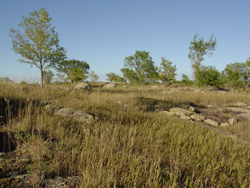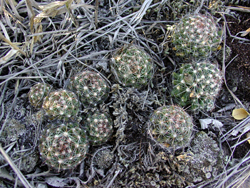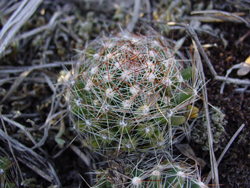The Fate of the Minnesota Ball Cactus
 The ball cactus (Escobaria vivipara) is one of Minnesota's rarest plant species. They only occur within a 2-3
square mile area in the west central part of the state in the Minnesota River valley. The ball cactus is associated
with granite outcrops that were exposed during the melting of the last glaciation. As glacial Lake Agassiz broke
to the south, it formed the glacial River Warren, which scoured the valley and exposed some of the oldest
rock in the world.
The ball cactus (Escobaria vivipara) is one of Minnesota's rarest plant species. They only occur within a 2-3
square mile area in the west central part of the state in the Minnesota River valley. The ball cactus is associated
with granite outcrops that were exposed during the melting of the last glaciation. As glacial Lake Agassiz broke
to the south, it formed the glacial River Warren, which scoured the valley and exposed some of the oldest
rock in the world.
Also found in the granite outcrops south of Ortonville, Minnesota are 8 other rare plant species, including Wolf's
Spikerush (Eleocharis wolfii), Hairy Water Clover (Marsilea vestita), Blackfoot Quillwort
(Isoetes melanopoda), Three-Stamened Waterwort (Elatine triandra), Mudwort (Limosella aquatica),
Larger Water-Starwort (Callitriche heterophylla), Water Hyssop (Bacopa rotundifolia) and Small White
Lady's Slipper orchid (Cypripedium candidum).
Some of Minnesota's ball cactus population is protected by the Big Stone National Wildlife Refuge which is
administered by the U.S. Fish & Wildlife Service. However, approximately 130 plants are in private ownership
and are in danger of being mined by a proposed granite quarry that is currently working its way through the
permitting process. The Strata Corporation, headquartered in Grand Forks, ND, is proposing to quarry 95 acres
in 3 separate phases. The mine areas will be 300' deep and the total aggregate mined will exceed 30 million
cubic yards. To uncover that granite, 1 million cubic yards of native prairie will need to be moved out
of the way. The granite will leave the mine on an overland conveyor belt that will load the aggregate
into rail cars.
  Escobaria vivipara
Escobaria vivipara at Big Stone Refuge near Ortonville, MN
The original plans called for destroying over 3,500 ball cactus and 14,000 specimens from the other 8
rare plants found on site. The Minnesota Department of Natural Resources would not permit that amount of
destruction of rare plants, so a rare plant protection area was established to save the most diverse
plant habitat on the property. The plans called for gifting the area to the adjacent Big Stone National
Wildlife Refuge. However, the refuge has declined the gift due to the amount of dust generated nearby
without a buffer, the odd shape which makes management nearly impossible, and the severed mineral rights.
Presently, no agency or non-profit organization has stepped forward to take on the management nightmare,
in essence stripping the idea of protection from the area.
During the planning process for the Big Stone County comprehensive plan, the citizens stated that they
valued and wished to preserve unique natural resources and wanted to keep natural areas functionally
intact. While the citizens in the area were kept in the dark during the planning process of the quarry
that has been ongoing since 2006, they have recently risen up to challenge the proposal. The nonprofit
organization CURE (Clean Up the River Environment) has been instrumental in providing advice and
organizing the citizens against the proposed quarry. The township, at the request of the local citizens,
has since passed an interim ordinance that places a moratorium on the project for 1 year.
What is the great economic return for destroying such an impressive view, destroying so many rare plants,
making airborne a tremendous amount of silica, draining wetlands and dewatering homeowner's wells, and
losing the ranching family that has grazed the native prairie for many decades? The county aggregate
tax on the granite mined will be about $20,000 per year. That amounts to 1/4 of 1% of Big Stone County's
revenue for one year. In fact, the neighboring homeowners pay that amount each year in property taxes.
If you would like to voice your concerns to the county commissioners, please visit the
Big Stone County website to find
contact information for the commissioners who will be voting on the conditional use permit before
May 21, 2012. To donate funds to defray the legal costs, please visit the CURE website at
http://curemnriver.org to donate to
their campaign to stop Strata outcrop mining.
Author: Shawn May
Detroit Lakes, MN
(Photos: Daiv Freeman)
|